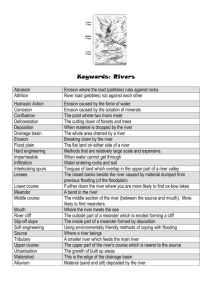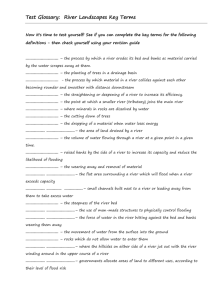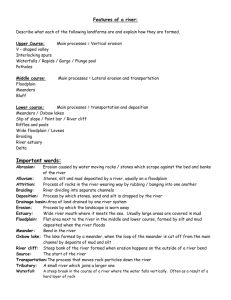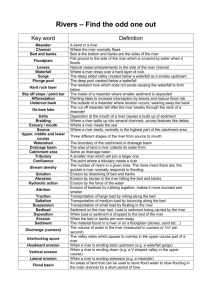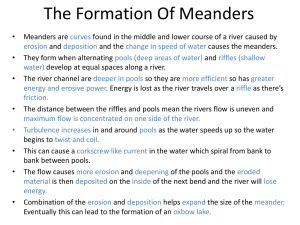River Processes - Think Geography
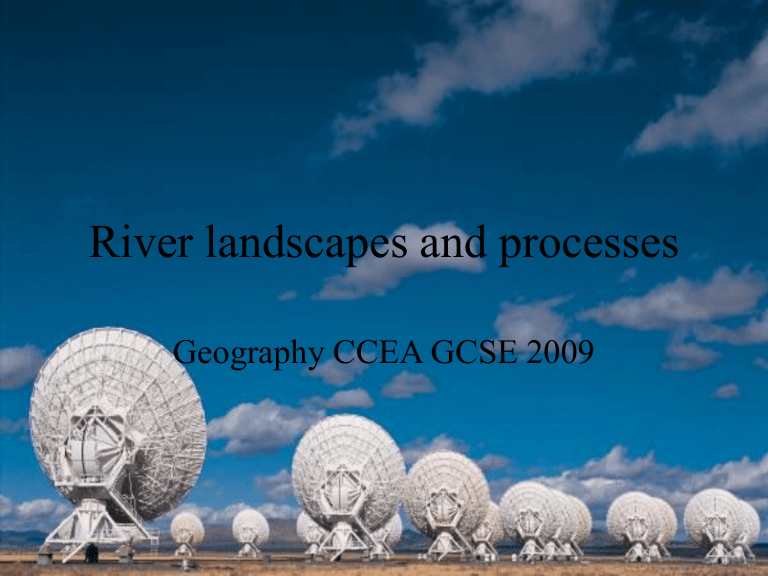
River landscapes and processes
Geography CCEA GCSE 2009
The earth’s crust is modified by fluvial processes which result in distinctive landforms
Stages in the
Development of a
River Valley
The river cuts downward to form a ‘V’shaped valley.
The river starts to meander
What happens next?
River uses its meanders to cut from side to side eating into the valley
1
2
Floodplain starts to form
What happens next?
1
2
What happens next?
Floodplain
River bluffs
River cliff
Alluvial deposits
River Processes
A river process is something that happens in the river. The main processes in the river are
Erosion - where parts of the river bed and bank get eroded / removed from the landscape
Transportation - where the eroded material is carried from one place to another through the river system
Deposition - where the river load becomes too heavy for the river to carry and is dumped down / deposited.
A river can erode material from its bed and banks in 4 main ways
• Abrasion – Moving water throws particles it is carrying against the bed and banks of the river which dislodges more material
• Hydraulic Action - The sheer force of the water pounding into the bed and banks can dislodge material
•
Attrition - Particles being carried downstream knock against each other, wearing each other down. This results in smaller, rounder particles as you move downstream
Use your text book to see if you can find the 4th type!
Methods of Erosion
•
Abrasion
–
•
Hydraulic Action -
•
Attrition -
•
Solution-
Methods of Transportation
• Rivers transport material in 4 main ways
•
Solution - Some minerals (particularly in limestone areas) dissolve easily in water and are not visible to the naked eye
•
Suspension
– As the speed or velocity of a river increases, it is able to pick up and carry larger and larger particles in its flow. Where particles are carried along in the flow and are not in contact with the river bed, they are said to be travelling in suspension.
Methods of Transportation
•
Saltation - Heavier particles may not be held in the flow all the time but may be bounced along the bed
•
Traction - The heaviest particles are rolled along the bed. Such particles may only be moved when the river has a large volume of water in it
Methods of Transportation
•
Solution -
•
Suspension-
•
Saltation -
•
Traction -
solution
River Features
• Rivers are eroding, transporting and depositing constantly within the drainage basin system.
• The river can be divided into 3 sections –
Upper Course at the Source, Middle Course and Lower Course at the Mouth of the river.
The river displays different characterisitics at each section
How to take notes on each of the River
Features!
Course: Upper / Middle / Lower
Feature: Eg Waterfall
Diagram to illustrate: (make sure that this is labelled!)
Notes to explain how the feature happens:
Example of this feature:
Make sure that you take a new page for each new feature!
The V - Shaped Valley
Can you mark the V-shaped valley’s on these photos?
• http://www.schoolportal.co.uk/GroupDownloadFile.asp?file=5
5027&Groupid=12426
How are V-shaped valleys formed ?
• Why does it erode downwards?
• How does it erode downwards?
Use this sketch to help explain how they form
Vertical abrasion
Also known as ‘Torrent’ or ‘Youth’ stages
Interlocking Spurs
In the Upper Course, the river is fast flowing, but there is little water and load. The river is often called a stream and does not have the erosive power to remove the hillsides (spurs), but erodes downwards instead.
EROSION TYPE: Vertical and Headward
Waterfalls and Gorges
1.
Draw the stages in the formation of a waterfall
2.
Explain in as much detail what is happening at 3
3. What is happening here?
(see next slide)
Waterfall formation flash
Case study:
Niagara Falls
Canada
USA
USA
Canada
Canada Horseshoe
750 meters
52 meters high
American Bridal Falls
330 meters
Both falls…the falls help to produce HEP
The falls erode back at a rate of 1.5 meters a year
Frozen Falls
20 million visit the falls every year
Visitors !!!
The Falls were stopped in 1969 to see if debris could be removed to improve the look !!
Hard Resistant
Rock - Limestone
Weak Rock -
Shale
52 meters
Gorges
(Upper & Middle Course)
Case study: Niagara Falls (USA and
Canada)
• http://www.school-portal.co.uk/GroupDownloadFile.asp?file=55026&Groupid=12426
Waterfall and Gorge 1
(OBLIQUE AERIAL VIEW)
EROSION
TYPE: Vertical and Headward
Waterfall and Gorge 2
(PROFILE VIEW)
EROSION
TYPE: Vertical and Headward
Use the Niagara Falls Pictures
PowerPoint
Notes to be taken from Page 10 from the Green Connections books
Meanders
2. What type of erosion do you think is happening?
1. Can you mark the fastest flow on this?
What is a meander?
..can you mark on this the fastest flow?
What is a meander
… where do you think erosion would take place?
What is a meander?
Can you draw a cross section x-y?
What is a meander?
… this is what a cross section through a meander looks like
Also known as the ‘Mature’ stage
Meanders 1
(Aerial View)
Meanders are formed because the current swings to the outside of a bend and concentrates the erosion there.
Deposition occurs on the inside of the bed where there is not enough energy to carry load.
EROSION TYPE: Lateral
Meanders 2
(Profile View / Cross
Section X - Y)
EROSION
TYPE: Lateral
This cross section clearly shows the eddy current (near ’X’) formed by the velocity of the river being concentrated on the outside of the bend.
These UNDERCUT the bank causing the formation of a RIVER CLIFF. On the inside (NEAR ‘Y’), a SLIP-OFF-SLOPE is formed where current is too slow to carry any load.
What is a meander?
… this is what a cross section through a meander looks like
Ox- Bow Lakes
(Middle Course)
Can you annotate this photo graph ?
Can you annotate this photo graph ?
Can you annotate this photo graph ?
Can you annotate this photo graph ?
What are Flood Plains and levees?
•
Floodplain
Levees
What is Meander Migration
…. What do you think might happen here?
What is Meander Migration
EROSION TYPE: Lateral
Ox-Bow Lake 1
(Aerial View)
Ox-bow lakes are formed when two meander
RIVER CLIFFS are being eroded towards each other.
These will eventually meet, causing the river to then flow across the bottom of the diagram.
Ox-Bow Lake 2
(Aerial View)
Levees
Leeves
River
Leveés and Raised Beds 1
(Front View)
DEPOSITION
FEATURE: no erosion in the Lower
Course
Leveés are formed when rivers flood. The river water overflows the banks of the river and immediately slows down due to friction with the FLOODPLAIN. This drops the larger particles first, building up a raised river bank called a
LEVEÉ.
Leveés and Raised Beds 2
(Front View)
DEPOSITION
FEATURE: no erosion in the Lower
Course
Raised beds form in the Summer months when the river volume and energy are low and load is dropped onto the river bed. The bed raises up and the capacity of the river reduces, causing flooding in the winter. This in turn builds up the leveés and the whole process raises up the level of the river in the landscape.
Braided Channels
(Oblique Side View)
DEPOSITION
FEATURE: no erosion in the Lower
Course
In the Summer months, load is dropped by the low volume of low-energy water in the river. These build up to form obstructions in the river and it divides up to flow around them.
In the winter, it is likely that the river volume will increase and remove these obstructions.
Deltas
Delta
(Aerial View)
This deposition feature is one of the largest. When the flowing river hits the non-flowing sea, energy is suddenly lost. This causes all of the load in the river to drop in the river MOUTH. This builds up over time to create a delta – an area of land. The river divides into DISTRIBUTARIES to continue to the sea, which is now some way away from its original meeting point.
Can you work out what the river is trying to do by using this diagram?
Can you work out what the river is trying to do by using this diagram?

